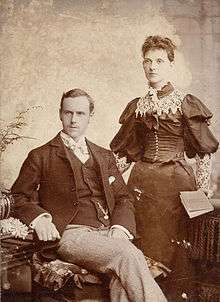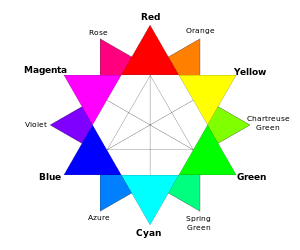Photographic print toning
In photography, toning is a method of changing the color of black-and-white photographs. In analog photography, it is a chemical process carried out on metal salt based prints such as Silver Prints, Iron Based Prints (Cyanotype or Van Dyke Brown), Platinum or Palladium Prints photographic prints. This darkroom process cannot be performed with a color photograph. The effects of this process can be emulated with software in digital photography. Sepia is considered a form of Black and White or Monochromatic Photography.


Chemical toning
Most toners work by replacing the metallic silver in the emulsion with a silver compound, such as silver sulfide (Ag2S) in the case of sepia toning. The compound may be more stable than metallic silver and may also have a different color or tone. Different toning processes give different colors to the final print. In some cases, the printer may choose to tone some parts of a print more than others.[1]
Toner also can increase the range of shades visible in a print without reducing the contrast. Selenium toning is especially effective in this regard. Some toning processes can improve the chemical stability of the print, increasing its potential longevity. Other toning processes, such as those including iron and copper, can make the print less stable. Many chemical toners are highly toxic, some even containing chemicals that are carcinogenic. It is therefore extremely important that the chemicals be used in a well ventilated area, and rubber gloves and face protection should be worn when handling them.
Selenium toning
Selenium toning is a popular archival toning process, converting metallic silver to silver selenide. In a diluted toning solution, selenium toning gives a red-brown tone, while a strong solution gives a purple-brown tone. The change in color depends upon the chemical make-up of the photographic emulsion being toned. Chloro-bromide papers change dramatically, whilst pure bromide papers change little. Fibre-based papers are more responsive to selenium toning.[2]
Selenium toning may not produce prints quite as stable as sepia or gold toning. Recently, doubts have surfaced as to the effectiveness of selenium toner in ensuring print longevity.[3]
- In most applications, selenium toning was not used for its sepia or red tone by fine art photographers. In fact it was used for the opposite of those effects
- Agfa Portriga Rapid and Agfa Record Rapid (the highest silver content black-and-white photographic paper made for the mass market) had a brownish-green tone. Depending on the strength of selenium tone mixed in water, a three- to four-minute tray bath, with continuous circulation, removed the brownish green tone and provided a deep rich black.
- Higher concentrations of selenium toning and longer tray baths produced the red effect. 99% of selenium-toned vintage prints in museums and sold at galleries and auction are toned to remove the brownish green tone and provided a deep rich black.
- Most reported tests over the years in technical photography publications gave selenium-toned prints twice the longevity of untoned prints.
Sepia toning
Sepia toning is a specialized treatment to give a black-and-white photographic print a warmer tone and to enhance its archival qualities. The metallic silver in the print is converted to a sulfide compound, which is much more resistant to the effects of environmental pollutants such as atmospheric sulfur compounds. Silver sulfide is at least 50% more stable than silver.[4]
There are three types of sepia toner in modern use;
- Sodium sulfide toners – the traditional 'rotten egg' toners (sodium sulfide smells of rotten eggs when exposed to moisture);
- Thiourea (or 'thiocarbamide') toners – these are odorless and the tone can be varied according to the chemical mixture;
- Polysulfide or 'direct' toners – these do not require a bleaching stage.
Except for polysulfide toners, sepia toning is done in three stages. The print is first soaked in a potassium ferricyanide bleach to reconvert the metallic silver to silver halide. The print is washed to remove excess potassium ferricyanide and then immersed into a bath of toner, which converts the silver halides to silver sulfide.
Incomplete bleaching creates a multi-toned image with sepia highlights and gray mid-tones and shadows. This is called split toning. The untoned silver in the print can be treated with a different toner, such as gold or selenium.[5]
Fred Judge FRPS made extensive use of sepia toning for postcards produced by the British picture postcards manufacturer Judges Postcards.
Metal replacement toning
Metal replacement toners replace the metallic silver, through a series of chemical reactions, with a ferrocyanide salt of a transition metal. Some metals, such as platinum or gold, can protect the image. Others, such as iron (blue toner) or copper (red toner), may reduce the life of the image.
Metal-replacement toning with gold alone results in a blue-black tone. It is often combined with a sepia toner to produce a more attractive orange-red tone. The archival Gold Protective Solution (GP-1) formula uses a 1% gold chloride stock solution with sodium or potassium thiocyanate.[6] It is sometimes used to split tone photographs previously toned in selenium for artistic purposes.[7]
Dye toning
Dye toners replace the metallic silver with a dye. The image will have a reduced lifetime compared with an ordinary silver print.
Digital toning
Toning can be simulated digitally, either in-camera or in post-processing. The in-camera effect, as well as beginner tutorials given for software like Photoshop or GIMP, use a simple tint. More sophisticated software tends to implement sepia tones using the duotone feature. Simpler photo-editing software usually has an option to sepia-tone an image in one step.
Examples
The examples below show a digital color photograph, a black-and-white version and a sepia-toned version.
 Color image
Color image Grayscale image
Grayscale image Sepia-toned image
Sepia-toned image
The following are examples of the three types using film:
 Color photograph
Color photograph Black-and-white photograph
Black-and-white photograph Sepia toning
Sepia toning
See also
- Color grading
- Cyanotype
- Film tinting
- Grisaille (painting)
- List of software palettes § Color gradient palettes
- Monochrome
- Platinotype
- Selective color
References
- Peres, Michael R. Focal encyclopedia of photography: digital imaging, theory and applications ... p. Page 686.
- "Selenium Toning". Ilford Photo. Archived from the original on 2007-09-27. Retrieved 2007-05-11.
- "Silverprint News May 07 - Not Fade Away..." Silverprint Ltd. May 2007. Archived from the original on 20 December 2009. Retrieved 18 March 2010.
- graphic-design.com
- "Photographers' Resources: Toning". Xero. Retrieved 2007-05-11.
- Adams, Ansel: The Print, page 94. Little, Brown, and Company, 1995.
- Bailey, Jonathan: "Split-Toning: Processes and Procedures," Camera Arts, February/March 2001.
External links
Chemical toning (formulas and technique):
- (Book) Photographic facts and formulas (1924) Many various toners (copper, iron, vanadium, selenium, sulphide, etc.)(p. 216)
- (Book) All about formulae for your darkroom (1942) Selenium, indirect sulphide toning, red chalk, blue and green tones (pp. 44–47)
- (Book) Kodak Chemicals and Formulae (1949) Selenium, sulphide-selenium and other toners (pp. 39–41)
- Ilford: Toning prints
- Sepia toning in a developing tray.
Digital "toning":
- Sepia Toner Application to convert digital images
- Sepia Effect Vintage sepia effect in Easy Photo Effects
- Sepia toning in Adobe Photoshop
- Sepia toning in the GIMP
- Sepia toning in Java
